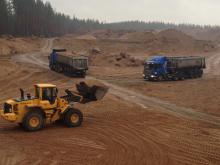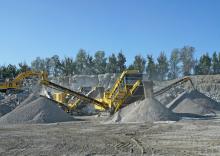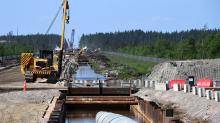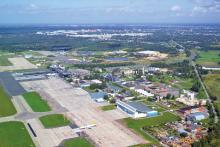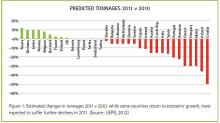
Aggregates production in the Baltic states is expanding, but local producers face a potential threat from increased volumes being exported to the region from Ukraine and Belarus. Eugene Gerden reports.
The aggregates industry in the Baltic states of Latvia, Lithuania and Estonia is steadily growing, amid the ongoing recovery of the region’s economies from the effects of the crisis that resulted from the Russian annexation of Crimea from Ukraine in 2014.
Currently, the aggregates industry in the Baltic states remains highly fragmented, characterised by the lack of dominant players in the market and relatively small volumes of production. The majority of local production facilities and quarries were established during the Soviet era and are in acute need of modernisation.
Analysts at the Russian Ministry of Industry and Trade warn that the expansion of aggregates production in the Baltics may be complicated by the recently announced plans of the Ukraine and Belarus governments to significantly increase their export volumes of aggregates (and in particular crushed stone) to the Baltic region during the next few years. The analysts say this may result in massive bankruptcies among local producers.
The implementation of large-scale infrastructure projects in the region is now being resumed after the Crimea crisis.
The road-building industry remains a major consumer of aggregates in the Baltic states, mainly due to a number of such large-scale projects. One of these involves the building of European route E67, an international E-road running from Prague in the Czech Republic to Helsinki in Finland by way of Poland, Lithuania, Latvia and Estonia. A number of other similar projects are also being implemented in the region.
Latvian prime minister Māris Kučinskis says that his country and the other Baltic states consider the building of the E67 to be a strategic project that will ensure good transport connections between all the countries in the region.
According to the Latvian government’s press service, the Ministry of Construction has, to date, signed several contracts for the supply of up to 100,000 tonnes of crushed stone for the E67 project with leading producers in Latvia and the other Baltic states.
The resumption of road-building activity in the region has already resulted in the acceleration of crushed stone and other aggregates production at the largest quarrying sites across the Baltic.
The Latvian Ministry of Industry and Trade says that since the beginning of 2017 production of crushed stone has increased by 1.5 times at the country’s largest sites, which include Birzha, Aiviekste, Kalnciems and Darzciems.
Production of sand in Latvia and the other Baltic states has also increased by around 50% to 30 million tonnes since the start of the year. Currently, the number of sand quarries in Latvia, Lithuania and Estonia is estimated at 40, with production increasing at the majority.
In addition to Latvia, the volume of aggregates production has also recently increased in neighbouring Estonia. A spokesman for Estonian prime minister Jüri Ratas said this was achieved through the attraction of private investors which included some Russian construction material producers.
Ratas says this investment has made it possible to establish new aggregates production sites in Estonia and to resume the development of other fields which were originally established after the collapse of the USSR.
According to Ratas, the Estonian government would welcome further modernisation of the existing production and processing facilities as well as the building of new ones. He says the government has upheld its promises to provide a package of benefits for local manufacturers and those making investments in the country’s aggregates production. These benefits mainly include exemption from certain taxes - in particular VAT and income tax - as well as customs and other benefits.
Estonia is particularly hoping to attract investment from Russia and the Nordic region. A spokesman for the Estonian government said negotiations about such investments are currently underway.
Several leading Estonian aggregates producers have now increased production over previous levels. These include AS Paekivitoodete Tehas, one of the country’s largest and oldest aggregates producers, which has significantly increased its sand and gravel production since the start of 2018.
Last year the company invested more than €10million in the launch of a new line for the production of sand and gravel at its Tallinn plant. It may launch a second line with the same capacity by the end of the current year.
An AS Paekivitoodete Tehas spokesman says that the processing of illiquid limestone reserves in sand and gravel is at the heart of the planned production. This will be conducted using technology developed in Northern Ireland by the Irish Salt Mining Exploration company at its facility in Carrickfergus.
According to Vladimir Libman, chairman of Paekivitoodete Tehas, the new technology makes it possible to produce sand and rubble from non-liquid limestone and will allow the company to significantly save on production costs. He added that it will also create conditions for further expansion of production, amid the ever-growing demand for aggregates from major industries in the country.
Libman said that, in addition to achieved savings on production costs, the new sand and gravel production line in Tallinn (and the planned second line) will allow for more complete processing of illiquid limestone stocks and will have a less negative impact on ecology. The project has received the support from the Estonian government and the authorities in Tallinn.
In the medium term, Paekivitoodete Tehas plans further expansion of production, mainly driven by the availability of a rich raw materials base which is estimated at about 3 million tonnes of illiquid limestone.
Mariah Yufereva, head of Lasnamäe, the most populous administrative district of Tallinn, says that more complete recycling of rubble in Estonia’s quarries will make it possible to significantly reduce the cost of road construction in the country as well as in the other Baltic states.
“In addition to the European route E67, a significant part of future production will be supplied for the needs of other large-scale infrastructure projects,” she adds. These include the building of Väo junction, one of the largest road-building projects in Estonia, that should significantly improve transport connections in the city of Tallinn. The use of new technologies during planned production will help to save city budget funds and allow more projects to be implemented.”
Both the Estonian government and Paekivitoodete Tehas are paying particular attention to increasing crushed stone production at the Viao and Maardu quarries, Estonia’s largest crushed stone quarries.
In Lithuania, leading local producers (including Akmenes Cementas, Nerydnya Materialy and some others) have recently announced plans to significantly increase the production and export of aggregates.

